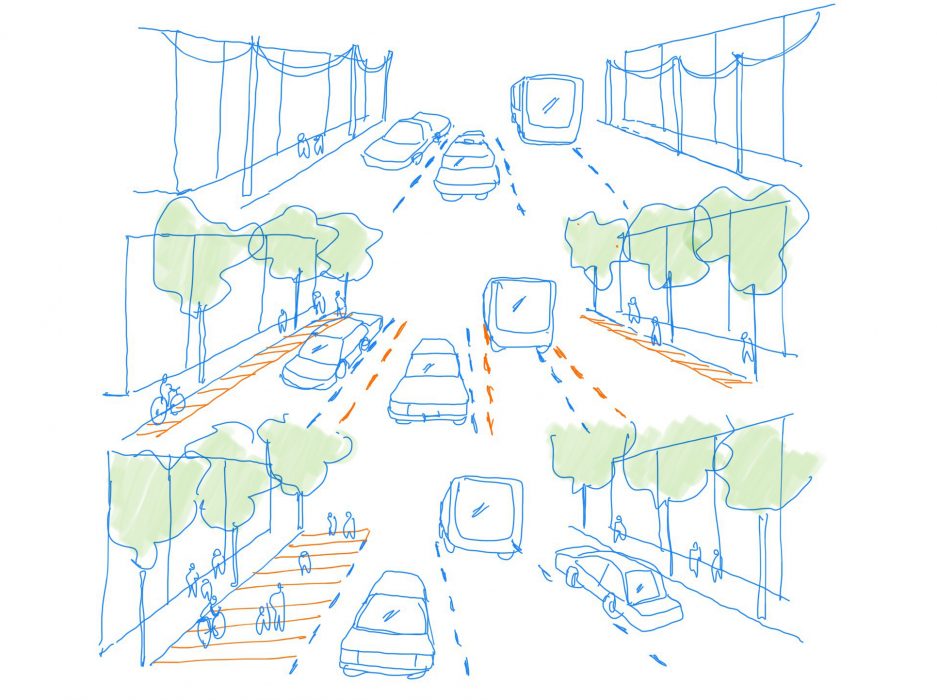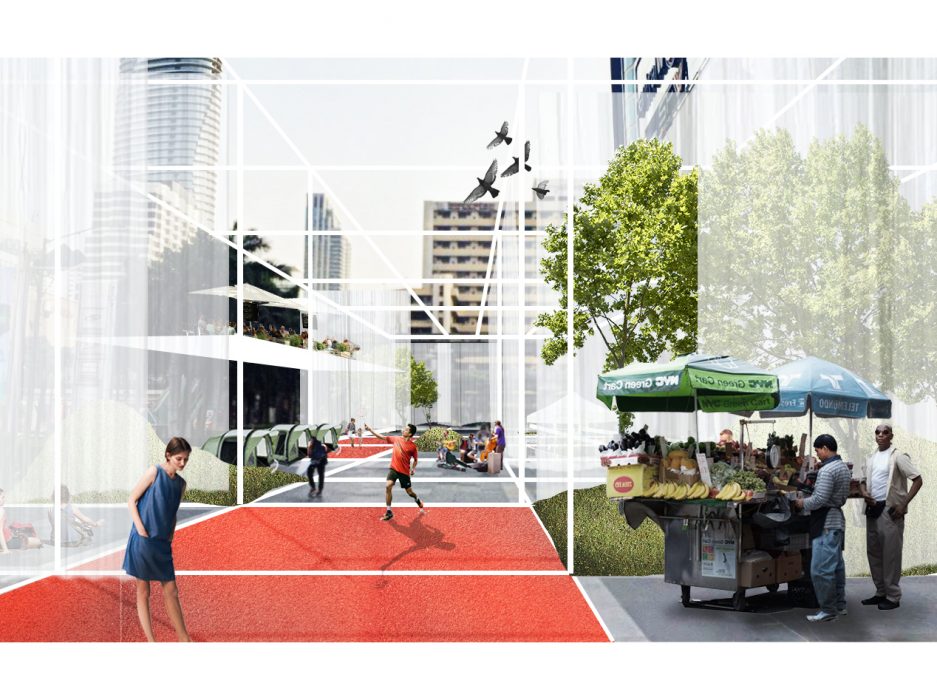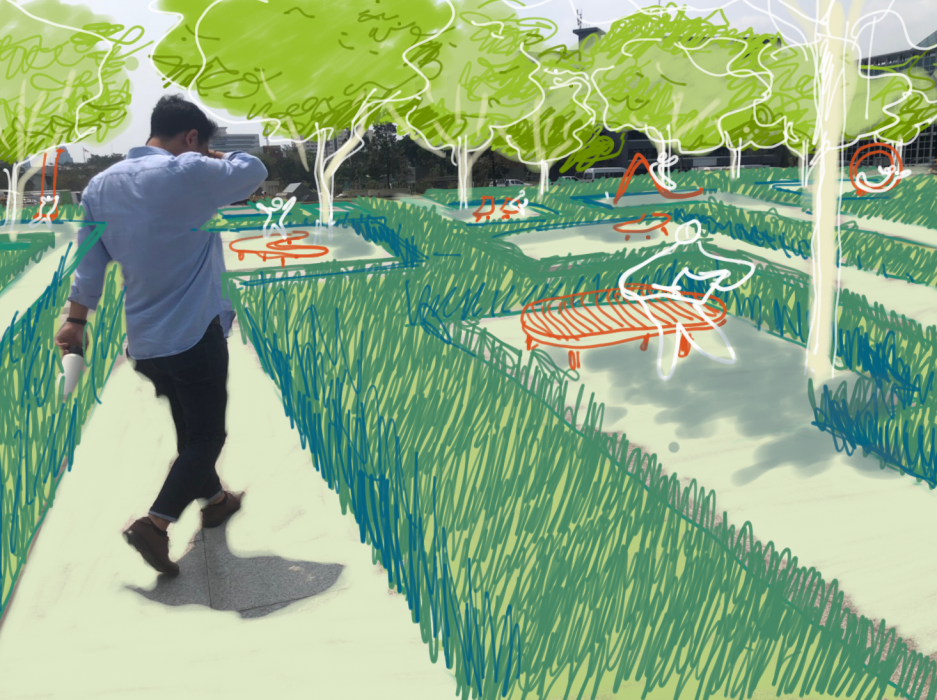CREATIVE SOLUTION
POST-COVID LANDSCAPE
โลกหลังยุค COVID-19 ทำให้ ‘ความใกล้ชิด’ กลายเป็นสิ่งที่ไม่ปลอดภัย ย้อนแย้งกับความต้องการปฏิสัมพันธ์ทางสังคมของคนเราอย่างที่พบเห็นในพื้นที่สาธารณะต่างๆ คำถามสำคัญคือ ต่อจากนี้เราจะใช้ชีวิตติดต่อกับคนอื่นอย่างปลอดภัยและมีความสุขได้อย่างไร เมืองที่ดีอาจต้องถูกปรับปรุงให้สามารถกระตุ้นพฤติกรรมแบบใหม่ของผู้คนอย่างมีชีวิตชีวา ยั่งยืน และยืดหยุ่นเพื่อรับมือกับภัยในอนาคตได้ โดยมีพื้นที่สาธารณะ ถนน ทางเท้า ลานโล่งเป็นปัจจัยควบคู่กันไปกับการพัฒนาเมือง ดังที่ผู้คนยังโหยหาอากาศบริสุทธิ์ สถานที่ออกกำลังกาย และพื้นที่สีเขียวธรรมชาติไว้พักผ่อนจิตใจ
ย่านใกล้บ้านอาจกลายเป็นสถานที่สำคัญที่เราพึ่งพาในชีวิตประจำวัน มีสวนสาธารณะ ที่พักอาศัย แหล่งเรียนรู้ สาธารณูปโภคต่างๆ ครบครัน เป็น “เมืองกระจาย” ที่เราสามารถดำเนินชีวิตโดยการเดินเท้าและจักรยาน ไม่ต้องเดินทางไกลเข้าสู่ศูนย์กลางเมืองเพื่อลดความแออัดและการกระจุกตัวของคนในย่านศูนย์กลาง เสริมด้วย “เมืองเหลื่อมเวลา” กำหนดโควต้าออกจากบ้านไม่เกิน 3 วันต่อสัปดาห์สลับกับการทำงานที่บ้าน ช่วยลดปริมาณผู้เดินทางเข้าเมืองและรถยนต์สัญจรบนท้องถนน ส่งผลดีต่อสภาพอากาศของเมืองไปด้วยในตัว
หากลองมองในสเกลพื้นที่นั้นๆ เอง ระยะห่าง 2 เมตร อาจเป็นคำตอบของการจัดสรรสเปซแบบใหม่ก็ได้ เราอาจแบ่งฟังก์ชั่นการใช้งานให้เป็นสัดส่วนมากขึ้น พื้นที่พบปะสาธารณะอาจออกแบบใหม่ให้มีทางเดินปลูกล้อมด้วยพืชพรรณสีเขียว เป็นวงกตที่มีที่นั่งพักผ่อน สนามเด็กเล่น โต๊ะกิจกรรม แยกเป็นซุ้มๆ กันไป มีเส้นทางวิ่งออกกำลังกายที่หลากหลายระดับหลายเส้นทางมากขึ้น หรือแม้แต่การขยายพื้นที่เช่นทางเท้าให้กว้างขึ้นจากการปิดถนนบางเลนเพื่อลดความหนาแน่น เพื่อให้ผู้คนสามารถรักษาระยะห่างใน “เมืองหลวม” และความปกติใหม่เช่นนี้ได้

The post-COVID-19 world makes ‘intimacy’ unsafe, contradictory to our basic need for social interaction as evidenced in public spaces. An important question: how can we live and contact one another safely and happily hereafter? Good cities may need to be improved for lively encouragement of new behaviors, that are sustainable and flexible for future risks. Public spaces, roads, sidewalks and open spaces should always be part of urban development, as people still need places with fresh air, physical exercises and nature for our recreation.
Our local neighborhoods may become more important for our daily lives, as they’re completed with parks, residences, knowledge centers and public utilities. In these “decentralized cities,” we can live our daily lives on foot and on bicycle, without having to travel to the centers, decreasing the density and overcrowd of the centers. This can be complimented by “time-lapse cities,” in which a maximum of three days outside home are allowed, with the help of Work from Home, lowering the number of daily commuters and road traffic as well as air pollution.
Looking closely at a specific area, the two-meter distance may be an answer to the new space management, with better proportion in accordance with work functions. Public meeting space may be redesigned to include walkways surrounded by green plants, in the style of a maze with sitting areas, children’s playgrounds and activity tables all in different kiosks. More different levels and routes of running tracks should also be provided. Sidewalks can also be expanded by closing some road lanes to reduce their density and to guarantee physical distancing in the “loose cities” and the New Normal.
fb.com/Shmadesigns
shmadesigns.com




